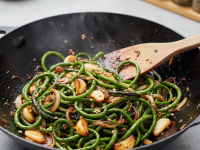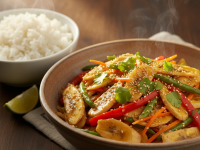Hey there, fellow food enthusiasts! Have you ever walked into a dim sum restaurant and been enveloped by that intoxicating aroma of steamed lotus leaves, hinting at a hidden treasure within? That, my friends, is the allure of Lo Mai Gai, or Lotus Leaf Wrapped Sticky Rice – a dish that’s as much an experience as it is a meal. Today, I’m beyond excited to share my personal journey and a tried-and-true recipe for this traditional delight. Trust me, it’s easier than you think, and the reward of unwrapping your own homemade, steaming parcel of aromatic goodness is simply unmatched.
For years, Lo Mai Gai was one of those dishes I only enjoyed when dining out. It seemed too complex, too “authentic” to attempt in my humble kitchen. But a few years ago, driven by a craving that just wouldn’t quit and a newfound determination, I decided to dive in. What followed was a delightful (and sometimes slightly messy!) adventure that transformed me from a timid admirer to a confident creator of this fantastic dish. And now, I want to guide you through that same satisfying journey.
Why Lotus Leaf? More Than Just a Wrapper
Before we even get to the ingredients, let’s talk about the star of the show (besides the sticky rice itself, of course!): the lotus leaf. This isn’t just for aesthetics, folks. The large, pliable lotus leaves impart a unique, subtly earthy, and incredibly fragrant aroma to the sticky rice as it steams. It’s an essential part of the Lo Mai Gai experience, infusing the rice and fillings with a fresh, botanical note that you simply can’t replicate with anything else. Think of it as nature’s perfect steaming pouch, keeping everything moist and infusing every grain of rice with its distinctive perfume. Plus, the unwrapping is part of the fun, a little ritual before you dive into the deliciousness within.
When you’re sourcing lotus leaves, you’ll typically find them dried in Asian supermarkets. They need to be rehydrated, which is a simple overnight soak or a quick hot water bath. Don’t skip this step! Properly softened leaves are crucial for wrapping without tearing and for releasing their full aromatic potential.
My Journey with Lo Mai Gai: From Kitcheewbie to Confident Cook
My first attempt at Lo Mai Gai was… ambitious. I remember trying to soak the sticky rice for only an hour, thinking it was enough. Big mistake! The rice turned out undercooked and hard in some spots. Then, there was the wrapping. Those beautiful, intricate parcels I’d seen in restaurants? Mine looked more like lumpy, confused little bundles. I overfilled one, and it burst during steaming. Another was too loose, and water seeped in, making the rice soggy. It was a learning curve, to say the least!
But here’s the thing about cooking: every “failure” is a lesson. I learned the critical importance of soaking the sticky rice overnight for that perfect, tender, yet chewy texture. I discovered the knack of not overfilling and practicing my folding technique (it’s like wrapping a tiny, delicious present!). I also experimented with the fillings – initially, I just used chicken, but soon realized adding Chinese sausage (lap cheung) and dried mushrooms elevated the flavor profile to another level. Each batch got better, each aromatic unwrapping more satisfying. And the smiles on my family’s faces? Priceless. That’s when I knew this recipe needed to be shared.
Gather Your Culinary Tools: Essential Ingredients for Authentic Flavor
Ready to embark on your own Lo Mai Gai adventure? Here’s what you’ll need. Don’t be intimidated by the list; many of these are pantry staples in Asian cooking!
For the Sticky Rice:
- 500g (about 2.5 cups) glutinous rice (sticky rice)
- 2 tablespoons oyster sauce
- 1 tablespoon soy sauce
- 1 teaspoon dark soy sauce (for color)
- 1 teaspoon sugar
- 1/2 teaspoon white pepper
- 2 tablespoons cooking oil (e.g., vegetable or canola)
For the Fillings:
- 300g boneless, skinless chicken thighs, cut into 1-inch pieces
- 4-5 dried shiitake mushrooms, rehydrated and sliced
- 2 Chinese sausages (lap cheung), sliced
- 1/4 cup dried shrimp, rehydrated
- 2 tablespoons chopped spring onion (green part only, for garnish)
For the Chicken Marinade:
- 1 tablespoon soy sauce
- 1 teaspoon sesame oil
- 1 teaspoon cornstarch
- 1/2 teaspoon sugar
- Pinch of white pepper
Other Essentials:
- 6-8 large dried lotus leaves, rehydrated
- Kitchen twine or aluminum foil for securing (optional, but helpful for begiers)
The Magic Unfolds: Step-by-Step Lo Mai Gai Recipe
Step 1: Prep Like a Pro
- Sticky Rice: Rinse the glutinous rice thoroughly until the water runs clear. Soak it in plenty of cold water overnight, or at least 4-6 hours. This is critical! Drain well before use.
- Lotus Leaves: Rinse the dried lotus leaves and soak them in warm water for at least 30 minutes, or until soft and pliable. If they’re very stiff, you might need to soak them overnight in cold water. Gently scrub them clean. Carefully cut off the tough central stem part. If your leaves are very large, you might cut them in half.
- Mushrooms & Shrimp: Soak dried shiitake mushrooms and dried shrimp in separate bowls of warm water until soft. Squeeze out excess water from mushrooms, trim stems, and slice.
- Chicken: Marinate the chicken pieces with the chicken marinade ingredients for at least 30 minutes.
Step 2: Cook the Fillings
- Heat 1 tablespoon of cooking oil in a wok or large pan over medium-high heat.
- Sauté the sliced Chinese sausage until lightly browned and fragrant. Remove and set aside.
- Add the marinated chicken to the same pan and stir-fry until cooked through. Remove and set aside.
- Add the rehydrated dried shrimp and sliced mushrooms to the pan. Sauté for 2-3 minutes until fragrant.
- Combine all the cooked fillings (sausage, chicken, shrimp, mushrooms) in a bowl.
Step 3: Season and Pre-cook the Sticky Rice
- Heat the remaining 1 tablespoon of cooking oil in the same wok.
- Add the drained sticky rice and stir-fry over medium heat for about 5-7 minutes. This step helps the rice absorb flavor and become more fragrant.
- Add the oyster sauce, soy sauce, dark soy sauce, sugar, and white pepper. Stir well to coat all the rice grains evenly. The dark soy sauce will give it that characteristic brownish hue.
- Pour in about 1 cup of hot water or chicken broth, cover, and let it simmer on low heat for about 10-15 minutes, or until the liquid is mostly absorbed and the rice is about 70% cooked. It should still be a bit firm. Stir occasionally to prevent sticking.
Step 4: The Art of Wrapping
- Lay a rehydrated lotus leaf flat on your work surface, shiny side up. If using two half-leaves, overlap them slightly to form a larger surface.
- Place about 1/2 cup of the pre-cooked sticky rice in the center of the leaf, flattening it slightly.
- Arrange a generous portion of the mixed fillings (chicken, sausage, mushrooms, dried shrimp) on top of the rice.
- Add another 1/2 cup of sticky rice on top of the fillings, gently covering them.
- Now, for the wrapping! Fold the sides of the lotus leaf inwards, then fold the top and bottom over, creating a neat, rectangular parcel. It’s a bit like wrapping a present. If you’re nervous about it opening, you can tie it with kitchen twine or wrap it securely in a piece of aluminum foil.
- Repeat with the remaining ingredients.
Step 5: Steam to Perfection
- Arrange the wrapped parcels in a large steamer basket. Make sure there’s enough space for the steam to circulate.
- Steam over high heat for 45-60 minutes, or until the sticky rice is fully cooked, tender, and incredibly aromatic. The longer steaming time allows the lotus leaf fragrance to fully permeate the rice and fillings.
Tips & Tricks for Your Best Lo Mai Gai Yet
- Don’t Skimp on Soaking: I can’t stress this enough! Proper soaking of both rice and lotus leaves is the secret to success.
- Taste as You Go: Especially for the rice seasoning. Adjust to your preference.
- Variations: Feel free to experiment with fillings! Some popular additions include salted egg yolk, roasted pork (char siu), or even chestnuts.
- Make Ahead: Lo Mai Gai freezes beautifully! Once steamed and cooled, you can wrap individual parcels in cling film and then foil, then freeze them. To reheat, steam directly from frozen for about 30-40 minutes.
- Watch Your Folding: If your leaves are tearing, they might not be soft enough, or you might be overfilling. Be gentle!
Serving Your Aromatic Masterpiece
Once steamed, carefully remove the parcels from the steamer. The aroma that fills your kitchen will be absolutely divine! Unfold the lotus leaf, sprinkle with some fresh chopped spring onion for a burst of color and freshness, and serve immediately. Dig in, and savor every tender, fragrant, flavor-packed bite. This dish isn’t just food; it’s a celebration of tradition, patience, and incredible flavor.
Making Lo Mai Gai at home is truly a rewarding experience. It coects you to a rich culinary heritage and fills your home with the most wonderful scents. Don’t be afraid to get a little messy, embrace the learning process, and most importantly, have fun with it. I promise, the first time you unwrap that perfect, steaming parcel of Lo Mai Gai you made yourself, you’ll feel an incredible sense of accomplishment. Happy cooking!


